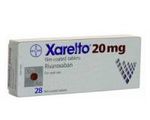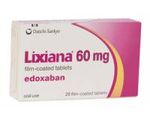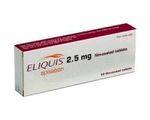Thrombosis can affect both men and women. Even young and athletic people can get thrombosis. The good news is that if caught early, thrombosis can be treated, so it's important to know what to look out for.

Thrombosis
What is thrombosis?
Treatments
- All treatments
- Prescription medicines
- Non-prescription medicines
- Relevance
- Name A-Z
- Name Z-A
- Price low-high
- Price high-low
How does Dokteronline work?
At Dokteronline, you can get expert advice from doctors quickly, without the hassle of visiting your GP’s surgery. Take care of your health with reliable treatments and information from the comfort of your home.
Select your preferred treatment
The doctor will review your medical request
The pharmacy will ensure your medication is delivered to your doorstep
Thrombosis is a blood clot that forms inside an artery or a vein. Blood clotting normally occurs to seal a wound and stop blood loss. With thrombosis, a blood clot will form without an injury or a cut. The blood clot that would normally cover a wound becomes larger and continues to grow to the point where it can block the flow of blood in the blood vessel. The clot can also travel through the bloodstream to another area of the body and cause blockage there.
What causes thrombosis?
There are three factors that contribute to thrombosis and disrupt the blood clotting response in the body. These factors are called Virchow's triad. Thrombosis occurs when the blood flows more slowly or the constitution of the blood changes due to trauma to a blood vessel. The following can increase your risk of developing these factors.
- Smoking;
- Pregnancy;
- Use of the contraceptive pill;
- Damaged blood vessels;
- An operation under anaesthetic;
- Genetic clotting disorders;
- Ageing;
- Cancer;
- May-Thurner syndrome;
- Atrial fibrillation;
- Sitting for long periods of time (e.g. on a plane);
- Long-term limited mobility of arms or legs.
One or more combinations of the above increases the risk of thrombosis.
What are the main types of thrombosis?
There are two main types of thrombosis:
- Arterial thrombosis (develops in an artery);
- Venous thrombosis (develops in a vein).
Arterial thrombosis is when the blood clot blocks an artery. The coronary arteries are the blood vessels that transport oxygenated blood to the heart muscle. Arterial thrombosis usually occurs in the coronary arteries. When blood flow to the heart muscle is blocked this can cause a heart attack. When a blood clot blocks a lung artery, this is called a pulmonary embolism. Blockage of an artery leading to the brain (carotid artery) can cause a stroke.
Venous thrombosis is a condition that occurs when a large blood clot forms in a vein. There are two types of venous thrombosis:
- Superficial vein thrombosis;
- Deep vein thrombosis.
The body has superficial veins and deep veins. Superficial vein thrombosis (SVT) is a blood clot formed in a vein near the surface of the skin, usually in the legs. The skin over the vein becomes inflamed. SVT is recognised by the presence of redness, swelling and pain or tenderness around the vein.
Deep vein thrombosis (DVT) occurs when a blood clot forms in one or more of the deep veins in your body. Deep veins are located in the muscles of the legs and carry blood back to the heart. They are crucial in maintaining a healthy circulation. The most serious complication of DVT happens when a part of the clot breaks off and travels through the bloodstream to the lungs, causing pulmonary embolism.
How do I recognise thrombosis?
There are different types of thrombosis and the symptoms vary depending on where the clot is formed.
Thrombosis in the legs or arms:
- Tightness of the skin;
- Local pain;
- Sudden swelling;
- Warm skin or heavy ache in the area of the clot;
- Blotchy red, white or blue appearance of the skin;
- Muscle cramps;
- Shiny skin.
Pulmonary embolism:
- Shortness of breath;
- Pain between the shoulder blades;
- Chest tightness;
- Elevated body temperature;
- Coughing or coughing up blood;
- Chest pain;
- Palpitations (heart racing).
How do I prevent thrombosis?
The most important thing you can do to reduce your risk of thrombosis is prioritise your health and avoid sitting or lying in the same position for long periods of time. A healthy lifestyle includes:
- A healthy and balanced diet;
- No smoking;
- Weight management;
- Wearing loose-fitting clothing;
- Putting your feet up when sitting or lying down;
- Drinking plenty of water;
- Regular exercise.
This will keep your blood vessels healthy.
There are also daily exercises that you can do to reduce the chance of thrombosis. The following exercises can be done several times a day:
- Stretching and bending toes;
- Walking in place;
- Doing leg raises.
How is thrombosis diagnosed?
If you have symptoms that indicate you may have thrombosis, a doctor will first go through a questionnaire with you and take a blood test. The blood test is decisive for further examination. If the blood test detects a substance in the blood that is released when a clot breaks up, an ultrasound or duplex examination or an angioplasty will be done. The doctor may also order a lung scan to rule out pulmonary embolism.
What treatment options are there for thrombosis?
There are many types of treatments for thrombosis. Anticoagulants are the medications most commonly used for thrombosis, possibly in combination with an elastic compression stocking. Anticoagulants are also known as blood thinners. They can reduce the risk of thrombosis or prevent a blood clot from getting larger. This allows the body the time to naturally break up the clot on its own.
Medication
Thrombosis is always treated with medication, but before medication can be prescribed a diagnosis must be made.
Medications used to treat thrombosis include:
- Heparin: an anticoagulant given by subcutaneous injection.
- DOAC: delays the action of coagulation proteins.
- Coumarins: reduce the action of Vitamin K. Vitamin K is required for the production of certain proteins involved in the blood clotting process.
- Antiplatelets: mild anticoagulants.
If you have had thrombosis in your leg, your doctor may suggest you wear a compression stocking to reduce swelling. The stocking also helps reduce your risk of varicose veins. You should wear your compression stockings during the day and take them off in the evening or before going to bed. Doctors generally advise prolonged compression therapy after deep vein thrombosis.
Lifestyle changes
If you have had thrombosis and are taking medicines, you will be monitored regularly by your doctor. Tests will be performed to measure your blood's clotting properties and adjust your medication accordingly. This can have a huge impact on your life. Treatment can take a long time and, after it's over, there are various things that you can do to prevent recurrence.
For example:
- See your doctor for check-ups.
- Mention you have a history of thrombosis prior to every medical procedure. This includes procedures done at the dentist or surgery.
- When you are travelling abroad ensure that you have an international medical statement issued by a doctor stating that you are being treated for thrombosis.
- Stay physically active.
- Avoid injury prone sports activities. Decrease the risk of bleeding.
- Make healthy food choices and listen to your body.
Additional risks and side effects
Each treatment for thrombosis has specific side effects. For a list of possible side effects, please refer to the original package leaflets.
What can you do to prevent thrombosis?
Although anyone can get thrombosis, some people have a greater risk of it than others. You may be at an increased risk of developing thrombosis if you have a genetic predisposition. Thrombosis can also be caused by body posture. Muscles that press on the blood vessels for a long period of time can cause clotting. This can happen as a result of sports activities or a growing belly in pregnancy.
You can protect yourself from thrombosis by maintaining a healthy lifestyle and breaking up long periods of sitting, standing or lying down by moving around. As thrombosis can have multiple causes, it is wise to make as many changes as possible in every aspect of your life that you can control.
Sources
Harteraad.nl (n.d.) Thrombosis. Consulted on 26-07-2021 via https://harteraad.nl/aandoeningen/trombose/?gclid=CjwKCAjwuvmHBhAxEiwAWAYjJebDxKJ8noGrBnHeUwNy5Op7Ugn7bGKJaB2s1sHfCjLab5Ky3TUjxoC6s4QAvD_BwE
Trombosestichting.nl (n.d.) What is thrombosis? Consulted on 26-07-2021 via https://www.trombosestichting.nl/trombose/wat-is-trombose/
The National Thrombosis Service (n.d.) Recognising Thrombosis. Consulted on 26-07-2021 via https://denationaletrombosedienst.nl/trombose-herkennen/#:~:text=Bij%20trombose%20onderscheiden%20we%20twee%20hoofdvormen%3A%20Arteri%C3%ABle%20trombose,%28krans%29slagaderen%20Veneuze%20trombose%20%E2%80%93%20trombusvorming%20in%20de%20aderen
Trombosiscare.be (n.d.) What is venous thrombosis? Consulted on 26-07-2021 via https://www.thrombosiscare.be/nl-BE/wat-is-een-veneuze-trombose/
The Netherlands Heart Foundation (n.d.) Thrombosis brochure of The Netherlands Heart Foundation. Consulted on 26-07-2021 via https://www.hartstichting.nl/getmedia/b1592d27-2e65-4e16-9608-1e1dd1b59ef5/brochurehartstichting-trombose.pdf
Trombosegids.nl (n.d.) Causes of thrombosis. Consulted on 26-07-2021 via https://trombosegids.nl/oorzaken-trombose/#:~:text=Mocht%20je%20last%20hebben%20van%20boezemfibrilleren%2C%20een%20hartritmestoornis%2C,ook%20meer%20risico%20op%20het%20krijgen%20van%20trombose.


